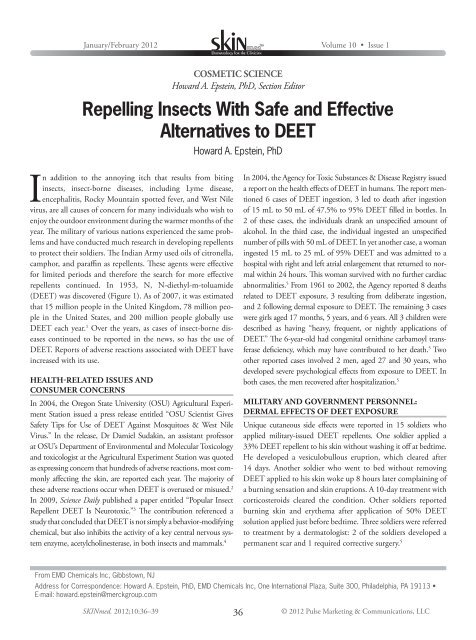January/February 2012 • Volume 10 • Issue 1 - SKINmed Journal
January/February 2012 • Volume 10 • Issue 1 - SKINmed Journal
January/February 2012 • Volume 10 • Issue 1 - SKINmed Journal
You also want an ePaper? Increase the reach of your titles
YUMPU automatically turns print PDFs into web optimized ePapers that Google loves.
<strong>January</strong>/<strong>February</strong> <strong>2012</strong> <strong>Volume</strong> <strong>10</strong> <strong>•</strong> <strong>Issue</strong> 1<br />
COSMETIC SCIENCE<br />
Howard A. Epstein, PhD, Section Editor<br />
Repelling Insects With Safe and Effective<br />
Alternatives to DEET<br />
In addition to the annoying itch that results from biting<br />
insects, insect-borne diseases, including Lyme disease,<br />
encephalitis, Rocky Mountain spotted fever, and West Nile<br />
virus, are all causes of concern for many individuals who wish to<br />
enjoy the outdoor environment during the warmer months of the<br />
year. The military of various nations experienced the same problems<br />
and have conducted much research in developing repellents<br />
to protect their soldiers. The Indian Army used oils of citronella,<br />
camphor, and paraffin as repellents. These agents were effective<br />
for limited periods and therefore the search for more effective<br />
repellents continued. In 1953, N, N-diethyl-m-toluamide<br />
(DEET) was discovered (Figure 1). As of 2007, it was estimated<br />
that 15 million people in the United Kingdom, 78 million people<br />
in the United States, and 200 million people globally use<br />
DEET each year. 1 Over the years, as cases of insect-borne diseases<br />
continued to be reported in the news, so has the use of<br />
DEET. Reports of adverse reactions associated with DEET have<br />
increased with its use.<br />
HEALTH-RELATED ISSUES AND<br />
CONSUMER CONCERNS<br />
In 2004, the Oregon State University (OSU) Agricultural Experiment<br />
Station issued a press release entitled “OSU Scientist Gives<br />
Safety Tips for Use of DEET Against Mosquitoes & West Nile<br />
Virus.” In the release, Dr Damiel Sudakin, an assistant professor<br />
at OSU’s Department of Environmental and Molecular Toxicology<br />
and toxicologist at the Agricultural Experiment Station was quoted<br />
as expressing concern that hundreds of adverse reactions, most commonly<br />
affecting the skin, are reported each year. The majority of<br />
these adverse reactions occur when DEET is overused or misused. 2<br />
In 2009, Science Daily published a paper entitled “Popular Insect<br />
Repellent DEET Is Neurotoxic.” 3 The contribution referenced a<br />
study that concluded that DEET is not simply a behavior-modifying<br />
chemical, but also inhibits the activity of a key central nervous system<br />
enzyme, acetylcholinesterase, in both insects and mammals. 4<br />
Howard A. Epstein, PhD<br />
In 2004, the Agency for Toxic Substances & Disease Registry issued<br />
a report on the health effects of DEET in humans. The report mentioned<br />
6 cases of DEET ingestion, 3 led to death after ingestion<br />
of 15 mL to 50 mL of 47.5% to 95% DEET filled in bottles. In<br />
2 of these cases, the individuals drank an unspecified amount of<br />
alcohol. In the third case, the individual ingested an unspecified<br />
number of pills with 50 mL of DEET. In yet another case, a woman<br />
ingested 15 mL to 25 mL of 95% DEET and was admitted to a<br />
hospital with right and left atrial enlargement that returned to normal<br />
within 24 hours. This woman survived with no further cardiac<br />
abnormalities. 5 From 1961 to 2002, the Agency reported 8 deaths<br />
related to DEET exposure, 3 resulting from deliberate ingestion,<br />
and 2 following dermal exposure to DEET. The remaining 3 cases<br />
were girls aged 17 months, 5 years, and 6 years. All 3 children were<br />
described as having “heavy, frequent, or nightly applications of<br />
DEET.” The 6-year-old had congenital ornithine carbamoyl transferase<br />
deficiency, which may have contributed to her death. 5 Two<br />
other reported cases involved 2 men, aged 27 and 30 years, who<br />
developed severe psychological effects from exposure to DEET. In<br />
both cases, the men recovered after hospitalization. 5<br />
MILITARY AND GOVERNMENT PERSONNEL:<br />
DERMAL EFFECTS OF DEET EXPOSURE<br />
Unique cutaneous side effects were reported in 15 soldiers who<br />
applied military-issued DEET repellents. One soldier applied a<br />
33% DEET repellent to his skin without washing it off at bedtime.<br />
He developed a vesiculobullous eruption, which cleared after<br />
14 days. Another soldier who went to bed without removing<br />
DEET applied to his skin woke up 8 hours later complaining of<br />
a burning sensation and skin eruptions. A <strong>10</strong>-day treatment with<br />
corticosteroids cleared the condition. Other soldiers reported<br />
burning skin and erythema after application of 50% DEET<br />
solution applied just before bedtime. Three soldiers were referred<br />
to treatment by a dermatologist: 2 of the soldiers developed a<br />
permanent scar and 1 required corrective surgery. 5<br />
From EMD Chemicals Inc, Gibbstown, NJ<br />
Address for Correspondence: Howard A. Epstein, PhD, EMD Chemicals Inc, One International Plaza, Suite 300, Philadelphia, PA 19113 <strong>•</strong><br />
E-mail: howard.epstein@merckgroup.com<br />
<strong>SKINmed</strong>. <strong>2012</strong>;<strong>10</strong>:36–39 36<br />
© <strong>2012</strong> Pulse Marketing & Communications, LLC


